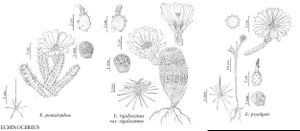Difference between revisions of "Echinocereus poselgeri"
Cactées, 57. 1868.
FNA>Volume Importer |
imported>Volume Importer |
||
| (5 intermediate revisions by 2 users not shown) | |||
| Line 8: | Line 8: | ||
}} | }} | ||
|common_names=Pencil cactus;dahlia hedgehog cactus;sacasil | |common_names=Pencil cactus;dahlia hedgehog cactus;sacasil | ||
| + | |special_status={{Treatment/ID/Special_status | ||
| + | |code=F | ||
| + | |label=Illustrated | ||
| + | }} | ||
|basionyms= | |basionyms= | ||
|synonyms={{Treatment/ID/Synonym | |synonyms={{Treatment/ID/Synonym | ||
|name=Echinocereus tuberosus | |name=Echinocereus tuberosus | ||
|authority=(Poselger) Rümpler | |authority=(Poselger) Rümpler | ||
| + | |rank=species | ||
}} {{Treatment/ID/Synonym | }} {{Treatment/ID/Synonym | ||
|name=Wilcoxia poselgeri | |name=Wilcoxia poselgeri | ||
|authority=(Lemaire) Britton & Rose | |authority=(Lemaire) Britton & Rose | ||
| + | |rank=species | ||
}} | }} | ||
|hierarchy=Cactaceae;Cactaceae subfam. Cactoideae;Echinocereus;Echinocereus poselgeri | |hierarchy=Cactaceae;Cactaceae subfam. Cactoideae;Echinocereus;Echinocereus poselgeri | ||
| Line 39: | Line 45: | ||
-->{{#Taxon: | -->{{#Taxon: | ||
name=Echinocereus poselgeri | name=Echinocereus poselgeri | ||
| − | |||
|authority=Lemaire | |authority=Lemaire | ||
|rank=species | |rank=species | ||
| Line 53: | Line 58: | ||
|publication title=Cactées, | |publication title=Cactées, | ||
|publication year=1868 | |publication year=1868 | ||
| − | |special status= | + | |special status=Illustrated |
| − | |source xml=https:// | + | |source xml=https://bitbucket.org/aafc-mbb/fna-data-curation/src/2e0870ddd59836b60bcf96646a41e87ea5a5943a/coarse_grained_fna_xml/V4/V4_333.xml |
|subfamily=Cactaceae subfam. Cactoideae | |subfamily=Cactaceae subfam. Cactoideae | ||
|genus=Echinocereus | |genus=Echinocereus | ||
Latest revision as of 21:57, 5 November 2020
Plants straggling, very tall and slender, sparingly branched at any level. Stems initially erect, later sprawling or clambering, long cylindric, 12–60(–130) × 0.6–1(–2) cm; ribs 8–10, crests low, uninterrupted or shallowly undulate; areoles 1–2–5 mm apart. Spines (9–)11–13(–17) per areole, stiff and straight, usually tan, brown, or black, sometimes yellow, pale pink, ashy white, or gray, sometimes black central spines contrasting with white radial spines; radial spines 8–16 per areole, 2–5 mm; central spines 1(–3) per areole, closely appressed (except at the stem tip), terete, 4–9 mm. Flowers 3.5–6 × 3.5–7 cm; flower tube 15–20 × 7–18 mm; flower tube hairs 3–5(–10) mm; inner tepals rose-pink with darker pink to magenta midstripes, proximally darker, 25–35 × 4–12 mm, tips relatively thin and delicate; anthers yellow; nectar chamber 1–4 mm. Fruits dark green to brownish, 2–3 cm, pulp white. 2n = 22.
Phenology: Flowering Mar–Apr; fruiting 2 1/2-3 months after flowering.
Habitat: Tamaulipan thorn scrub, alluvial soils
Elevation: 0-200[-1100] m
Distribution

Tex., Mexico (Coahuila, Nuevo León, Tamaulipas).
Discussion
Echinocereus poselgeri, with tuberous roots and erect, slender, elongate stems, superficially resembles some Peniocereus species. The polyphyletic genus Wilcoxia Britton & Rose formerly included this species along with species of Peniocereus. The flowers, fruits, and seeds of E. poselgeri are typical for Echinocereus, quite similar to those of E. reichenbachii.
Selected References
None.
